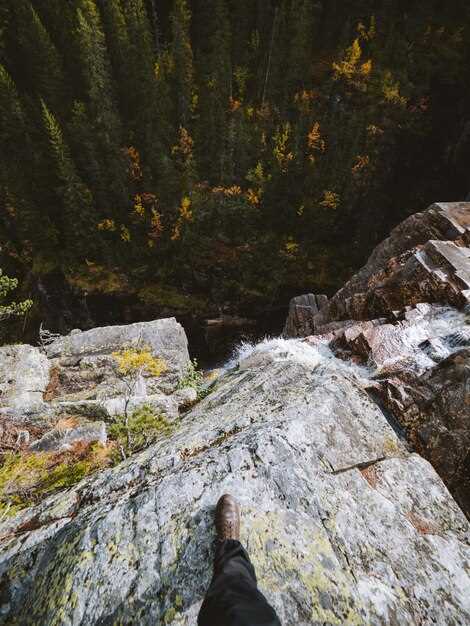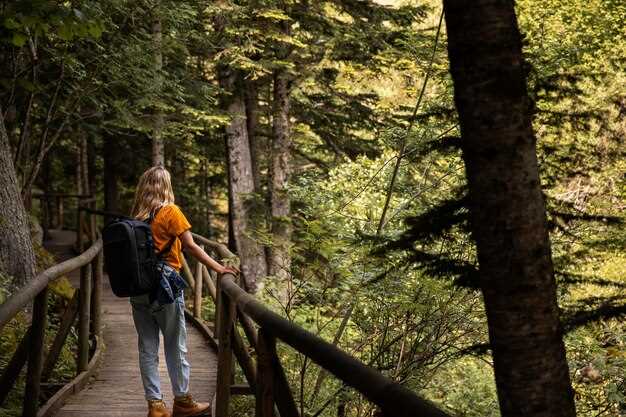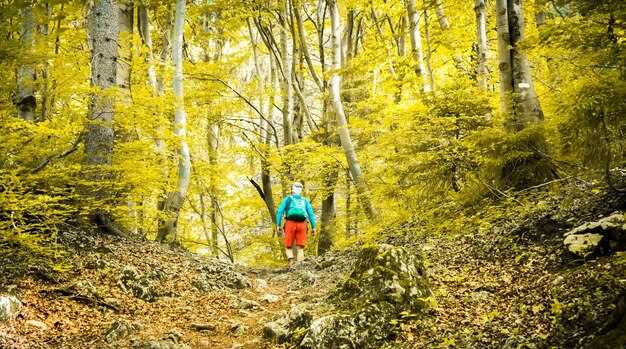
Arrive before dawn to see the golden light sweep across the ravine and the foliage glow. The kopparhattsrundan loop offers a gentle start with level gravel underfoot and dramatic cliff views that open to woodlands and the river threading through the park. If you arrive early, you’ll find quieter trails and a better chance to photograph the reflections.
The park features dramatic cliffs, rich woodlands, and streams that carve the ravine. Along the trails you will see evergreen pines and birch with golden leaves in autumn; look for quiet side paths that reveal overlooks and pockets of foliage that glow in the sun.
For staying, choose a cozy house or guesthouse in nearby towns; the price reflects seasonal demand but remains reasonable for easy access to kopparhattsrundan. If you prefer other lodging styles, consider a small apartment or hostel; quality rooms with private baths and warm hosts make mornings simple, and most options include breakfast or a kitchen to prepare a quick lunch for the trail.
There are varied activities for all ages: hiking, birdwatching, and photography. The routes are well marked, and compact maps are available on site. Plan to arrive at the visitor center for updated trail conditions, parking, and family-friendly options. The fourth mile along the main route is a nice checkpoint for a rest and a snack.
Over the years, the ravine transforms with light, rain, and seasonal foliage. Autumn brings the brightest gold, while spring greens revive the woodlands after winter. Early mornings offer calm water reflections and fewer crowds, while late afternoons invite dramatic silhouettes as the sun dips behind the cliffs.
To plan efficiently, visit local pages and resources such as wwwbastadcomen and search for names like kopparhattsrundan. Use the look of the ravine to guide your day and enjoy a safe stay with clear trails, water bottles, and sun protection. Find the best routes, check current status, and arrive prepared for a memorable day in Söderåsen.
A practical hiking plan for Söderåsen’s golden ravine in Skåne
Park at Skäralid parking and follow the marked trail into Söderåsen’s golden ravine for trek_distance: 7-9 km. This loop takes about 3–4 hours, with a lunchtime pause at the main overlook. Start around 09:00 to catch the best light, enjoy inviting front views, and watch the lichen glow as you move along the canyon walls.
Outward, stay on the ridge path for about 2.5–3 km to the northern overlook, then descend into the ravine via wooden stairs and switchbacks to a scenic point with sweeping views. The return follows a forest trail that climbs back to the rim and onward toward Skäralid meadow; plan five stable viewpoints and an opportunity for photos.
Sometimes weather changes quickly. Carry a light rain shell, water, and sturdy boots; stay on markers for safe passage and watch for wet roots near the edges. For each person, allocate a short five-minute water break after major stretches.
Food strategy centers on a lunchtime break with sandwiches, fruit, and water from local producers. A sheltered spot near the ravine front provides a quiet moment to absorb the romance of light across the walls. This hike reveals the intrinsic beauty, fall colors, the history and past that shaped these gorges, and the opportunity to share a meal with your group.
From Linköping to Söderåsen, regional travel plans fit well with a stay in nearby towns and a ride by regional transport to Skäralid. The coastal climate means wind and dampness can shift quickly; pack a windproof layer and check the afternoon forecast. The director and welcome staff at the park desk provide maps and a tailored plan; this will help you keep the hike safe and smooth on onward legs.
Along the route, note small dunes visible in the broader coastal fringe of Skåne, a reminder of the area’s sand history. Always mark your location on the map, and respect the posted signs to protect both you and the natural site as you pass from one viewpoint to the next.
When to visit for autumn gold and sunrise views
Visit Söderåsen in the second half of October for peak autumn gold and sunrise views. The copper and rich gold of aspen and birch light up the Skäralid canyon, and dawn light spills across the treetops. Target Kopparhatten or the Skäralid overlook by 06:30–07:15 to catch the moment when the valley wakes.
Stay in accommodation nearby to maximize time on site. Options around rönne-area stays provide easy access, while small towns nearby offer classic countryside comfort. A nearby café serves hot coffee and light bites, and markets selling delicacies give you a tasty recap after your morning walk.
Driving early gives you the advantage: reach the viewpoints before crowds, then explore higher elevations for far views. A light mist creates a suspension in the air at first light, and the valley glow shifts as the sun climbs. This moment is about the quiet and the glow.
Choose a version of your itinerary that fits your pace and your choice of routes: short, classic loops or longer canyon circuits. The season’s light delivers a royalty-like glow across copper and gold, a palace of color over the ravine.
Even if you visit in spring, Söderåsen offers a rich display. Together with danish visitors, you share the hush of dawn and the evolving light across the worlds of nature. This is the society of hikers who chase sunrises, and a morning you’ll want to repeat with another version of the route–driving out with a heart full of memory and a palate full of delicacies from a nearby café.
Trail options: easy to strenuous routes around the ravine
Begin with the Easy Riverside Loop, a 2.8 km, 60 m ascent, and a safe, family-friendly path along the ravine floor. Todays pace of life benefits from this close-to-nature start. Park in the main lot (Nissan and other makes welcome); fresh air and steady footing keep you comfortable. Designated swim spots let you cool off, and the amphitheatre clearing offers a natural seating area for a short break.
For a more expanded view, the Ridge Heights Path adds about 5.4 km with 180 m of elevation gain, featuring rugged switchbacks and panoramic overlooks. If you prefer a longer day, continue toward tällberg-inspired vistas where vineyards peek through the trees. Take separate breaks to avoid fatigue and keep the group moving at a comfortable pace.
The Family Canyon Connector runs 3.2 km with gentle grades and shallow river crossings, making it ideal for a group with children. Enjoy countryside views, several picnic spots, and spaces to cater a light meal for the whole crew. The route stays safe and well marked, with easy access to viewpoints and a small amphitheatre-like area for stories.
Ravine Traverse delivers a rugged 7.2 km challenge with 360 m of elevation, rocky steps, stream crossings, and dense tree cover. This route suits continuing hikers seeking a workout and dramatic scenery. Pack light but bring water, snacks, a compact first aid kit, and a headlamp for shaded sections. Stay on the trail to protect the landscape and enjoy the solitude along the canyon walls.
Check constraints and current conditions at wwwbastadcomen; this site also outlines parking, group facilities, and practical tips for navigating the Skåne countryside trails, with notes on safe access and times for larger groups enjoying outdoor days in the area.
| Trail | Etäisyys (km) | Elevation gain (m) | Difficulty | Kohokohdat | Best for |
|---|---|---|---|---|---|
| Easy Riverside Loop | 2.8 | 60 | Easy | ravine floor, amphitheatre clearing, designated swim spots, fresh air | families, first-timers |
| Ridge Heights Path | 5.4 | 180 | Moderate | panoramic overlooks, rugged switchbacks, views toward tällberg | active hikers, photo lovers |
| Family Canyon Connector | 3.2 | 120 | Easy-Moderate | shallow streams, picnic areas, separate viewpoints | groups with kids |
| Ravine Traverse | 7.2 | 360 | Strenuous | rock stairs, waterfalls, rugged walls, amphitheatre seating | experienced hikers |
Navigation basics: maps, GPS, and trail markers
Begin with a printed map from naturum and a charged GPS; lock satellites within five minutes before you step onto the trail.
- Maps and orientation
Use a current topographic map to identify narrow ravines, islands, and the majestic cliff faces of skånes. Orange markers guide most routes; align the map with the terrain by spotting a bend in a stream, a rocky outcrop, or a switchback that reappears later. Check the naturum panel for section-specific notes, current options, and constraints that could affect your plan. If you plan snacks, choose menus that fit your diet and provide steady energy; keep a warm layer handy for sudden weather changes. Note fall colors on the hillside and imagine the theatres of light that shift as daylight fades. Mark key landmarks on the map so you can return if needed.
- GPS usage and power management
Enable offline maps or pre-load the route before you leave shelter; keep the device in battery saver mode and close nonessential apps. In sections where you pass above gaps or near cliffs, the signal may drop–rely on your map and compass to stay on track. If you lose the track, return to the last known junction, reorient toward the main route, and monitor your returns on the map. Carry a small power bank and refresh the GPS every few hours to avoid a dead unit in late afternoon light.
- Trail markers and decision points
Follow orange markers; when a marker is missing, cross-check with the map at the last confirmed point and choose an alternative, then backtrack if needed to the previous section. For longer exploring with friends, agree on a meeting point and a time to return to naturum if someone goes off course. Be mindful of branches that swing overhead; stay on the established path to protect fragile ground and wildlife such as birds. Islands or side trails may appear; verify them against the map before branching off. If you encounter a barrier you cannot pass, use a safe detour rather than pushing forward into restricted zones. Use a simple rhythm to keep pace, and keep brakes in check on steep segments. In all cases, review your plan and communicate with the group to avoid getting separated. If you want to know where to turn, check the past markers and the last returns to the main route; the section layout on the map helps you stay oriented.
Practical tips and notes: bring extra water, a warm layer, and snacks from the menus suitable for your diets; if you are exploring with a partner or friends, designate a section to cover and agree on a shared route. The naturum provides current route options that help you adjust on the fly, especially around fall light and the orange markers along the ravine. For safety, plan an alternative loop that returns you to the main trail; this approach keeps you in control and reduces fatigue. Consider carrying smoked nuts or dried fruit for quick energy and a compact map for quick checks. While on the trails, stay mindful of the birds and the seasonal changes; the path sometimes narrows to a narrow strip along the water, so watch your footing and return before darkness falls.
Safety and etiquette for beech forest hikes

Wear sturdy boots and stay on marked trails from arrival to departure.
-
Gear and readiness
Carry water (at least 1 liter per person), a lightweight rain shell, and a small first-aid kit. Check boolfielddata for current trail conditions; alerts are shared at local huts and by Nilsson at Gullbranna, who offered updated maps after the last season. Pack a compact map or offline GPS, a compass, and a charged phone for emergencies. For a home-friendly touch, apply a light layer of tick repellent and inspect each other for ticks before leaving the car.
-
Trail etiquette and pace
Limit noise to respect wildlife and other hikers. Step aside on narrow sections to let faster travelers pass; please keep dogs on a leash and under voice control. Watch for beech roots and slippery leaf litter near Styggforsen and along ravine edges, where footing can shift quickly. When you stop, move off the path briefly to let others through and avoid trampling saplings.
-
Environment and waste
Carry out all litter; use reusable containers when possible. Do not move fallen branches or disrupt mossy cushions that protect soil; leave what you find for others to enjoy years from now. If you pause for lunch, choose a cleared spot away from fragile understory and keep campfires off-slope unless a designated area is present.
-
Wildlife awareness and safety
Be mindful of ticks after leaving grassier clearings; perform a quick tick check when you reach a sheltered shade area. In beech forests, small creatures and birds stay hidden in the dense canopy–listen for distant calls but refrain from chasing or feeding wildlife. Styggforsen and other waterfall corners can attract wind gusts; secure hats and glasses as you approach exposed edges.
-
Local culture, guidance, and etiquette
Respect local knowledge shared by swedes and visiting hikers alike. Guides and artisans along the southwest coast, including Bastad and Vadstena travel hubs, often offer short, practical tips; last-year conversations with Nilsson in Gullbranna highlighted safer routes and times when trails are less crowded. If you see posted notices about arrivals or special tours, consider joining to learn how to protect fragile beech stands and how to read continental-style trail markers.
-
Seasonal planning and tips
Plan around daylight windows; autumn light can transform the beech ravine into a golden corridor, making amazing views but shortening usable hours. In spring and early summer, moist leaf litter increases slipperiness; adjust your pace accordingly. For a refreshing break, aim to reach sheltered spots before noon, then head back along return routes that keep you away from steep drop-offs near Styggforsen.
-
Travel notes and community action
If you’re touring through Skåne, map a route that includes Gullbranna, Bastad, and Vadstena to experience varied scenery and local culture. Swedes and travelers alike appreciate clear, respectful conduct; sharing tips with fellow hikers creates a safer, more enjoyable experience for all. Some groups offer on_sale guidance materials and short safety checklists to help visitors stay refreshed and prepared after years of trail use.
What to pack: daypack checklist for a golden ravine hike

Choose a 20–25 L daypack with a waterproof outer layer, a lightweight rain cover, and a supportive hip belt. This setup promotes intrinsic comfort throughout a long hike along the golden ravine, even when the sun dips behind rock faces.
Layer wisely: moisture-wicking base, mid-layer fleece, and a windproof shell. Pack a warm hat and gloves; temps can drop near the ravine walls after midday heat.
Footwear and gear should handle varied terrain from the vallda access road to damp sections near the baltic coast. Wear sturdy boots with ankle support and bring two pairs of socks; add gaiters if the weather turns damp. Local dwellers know the area for quick assessments. The gear you carry is used across seasons and ensures readiness for surprises.
Navigation tools include a map, a compass, or offline GPS; a charged phone with a downloadable trail map; and a small whistle. Keep a short string to secure gear in windy moments. The area features varieties of microclimates along the ravine, dating back to old routes.
Water and energy: carry 1.5–2 L of water per person, plus a lightweight electrolyte option. Pack snacks with long-lasting energy from varieties such as nuts, dried fruit, and seed bars; also include a compact utensil and a folding sit pad for comfort.
Safety and first aid: a compact first-aid kit; personal medications; a contact card for a doctor; sunscreen; insect repellent.
Accommodation options near Söderåsen vary; decide your turnaround time before you set out, and name your route on the checklist so progress can be tracked. This plan, created to fit your schedule, helps you decide that safety comes first in this area.
Left-behind items: do a quick check to ensure nothing is left on the trail, especially small tools, wrappers, or torn tape.
Local resources: for accommodation and trail updates, visit wwwbastadcomen. Also, consider how the road network connects towns along the baltic coast; this beautiful landscape invites warm welcomes from the dwellers.
The golden ravine rewards careful packing with comfort throughout the day and leaves you with a beautiful, memorable walk in a landscape whose name was created by generations of visitors dating back across centuries.
